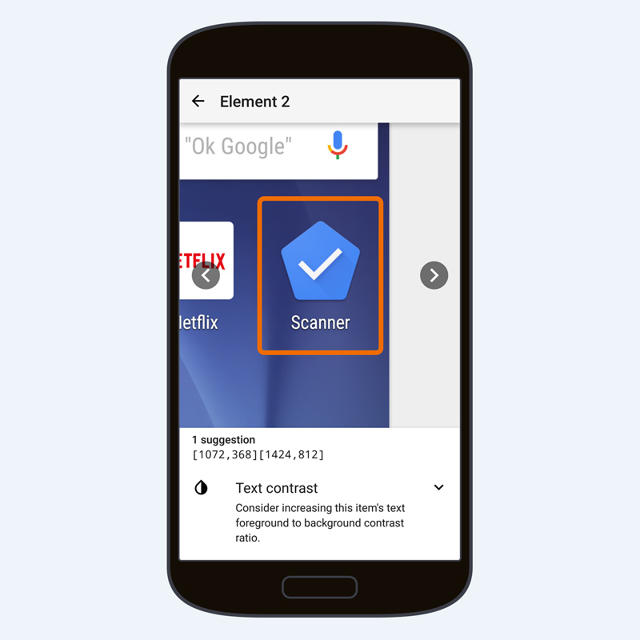Google built An App That reviews other Apps
if you happen to haven’t heard the time period “inclusive design” but, you will soon. It’s a easy concept: through designing to accommodate folks with disabilities, we can make merchandise that are higher for everyone. just look at the typewriter, at first invented to help a blind individual write letters. the theory is outdated, but the motion is choosing up speed as corporations comparable to Microsoft are the usage of it at the core of their design philosophy.
Now, in its personal nod to the development, Google has released an Android app called the Accessibility Scanner. With the touch of a button, it permits you to analyze any reveal or app for your cellphone for accessibility and inclusivity—in other words, how neatly it’s going to work for folks with sight or high quality motor control considerations.
We made up our minds to run one of the Google Play retailer’s most popular apps in the course of the Accessibility Scanner grinder. And shock! Social networks, infamous for trying to attract youthful users, didn’t accomplish that neatly. but whereas the app itself is very well designed, it also illustrates how complicated ideas of accessibility and design may also be in follow.
The Winners & The Losers
-
Kik
-
Snapchat
-
Instagram
-
fb
-
Netflix
-
Spotify
-
Accessibility Scanner
First up? Kik. in this seemingly naked-bones messaging app, literally each component on the chat reveal used to be flagged for being too small, or now not contrast-y sufficient. Instagram was once every other giant drawback UI: pretty much every component is flagged for measurement, with the exception of the photos themselves. Then there was once Snapchat. With simply five suggestions, it doesn’t appear to be an egregious offender—until you understand that virtually each one of the vital app’s Spartan elements has been flagged. The app really useful that buttons be enlarged, and stated that monitor readers won’t have the ability to identify components of the screen for the visually impaired.
after all, Snapchat purposefully isn’t designed for accessibility. As founder Evan Spiegel as soon as advised the day by day Mail’s Jon Steinberg after he complained that the interface wasn’t intuitive enough: “You’re now not really the goal.”
facebook was also in particular painful. A photo on the very top of my facebook feed incorporated 22 urged enhancements. They ran the entire gamut. distinction. measurement. and some merchandise descriptions were duplicated, making navigation by means of automated speakable textual content more difficult. notably, parts such as the untapped Like button were decided to be too low in contrast, as they were rendered in grey reasonably than black. it’s an example of how information hierarchy—and the fact that the user is not speculated to be drawn to a grey Like button at the cost of the eye-catching black textual content of a news post—is getting flagged via Google for its limitations in accessibility.
no longer every widespread app had accessibility problems, although. Netflix’s home reveal stuffed with movies and displays was once the one thing we examined with zero enhancements supplied. The UI seems to profit from its naturally excessive-contrast branding, together with huge pictures. Spotify used to be every other superstar of accessibility. Its primary web page wanted no adjustments, while its inside album pages had only a few size-primarily based and labeling complaints. once more, we see how a high-distinction interface would not just seem to be excellent—it is available for a bigger number of customers.
the grey area
Google doesn’t assist you to run a scan on the Accessibility Scanner app itself—we tried—but you can scan its app icon from the home screen. the usage of a Samsung Galaxy S6, with a inventory blue backdrop, the Accessibility Scanner referred to as out its own app icon for being too low-distinction.
That ironic contradiction presentations simply how complicated accessibility is to interface design—even when you’re being thoughtful. It’s obtrusive that almost all “mistakes” spotted by using the system are the results of cramming buttons and information onto a display that’s tiny by way of nature. So is the UI the problem, or is it a broader problem of UX? Smartphones themselves may no longer be all that obtainable, simply because of their dimension.

The app raises different questions. As one commenter in the Google Play retailer points out, Google’s subject matter design approves of both grey text and the three-dot contextual menu buttons that the Accessibility Scanner flags as frustrating. grey textual content in particular was some other drawback in nearly each app I examined with the scanner. but grey text is obviously being deployed via designers for an extraordinarily specific motive—to reduce a user’s center of attention on a selected piece of information.
Snapchat, for example, grays out a Snapchat Story except it’s fully cached and ready to watch. facebook grays out the Like and Share buttons (unless you faucet on them) as a result of you’ve considered them each thousands of occasions. These parts are, essentially, less obtainable through design. So do they wish to be rethought? Or are they, genuinely, just right?
And so as your complete concept of inclusive design—designing for everyone by designing for disabilities first—continues to seize cling, it’s price watching whether or not corporations like Google will drink their own Kool-aid, and whether or not or now not subject matter design requirements will change to accommodate all users. even if it way an finish to the gray areas.
All photography: by means of Google
(4)




















